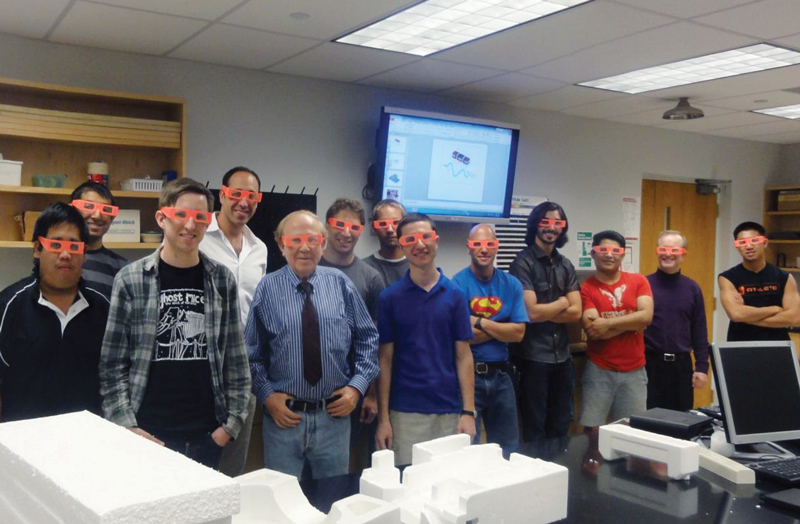The Magnetic Curlmeter
Fall
2014
Building Blocks - Undergraduate Research and Outreach Projects
The Magnetic Curlmeter
Experiments With Toroids
By:Armian Hanelli and Cyrus Hossainian
Northern Virginia Community College

James Clerk Maxwell, the father of electrodynamics, had a fondness for donuts—more specifically, for donut-shaped objects wrapped in wire.
In 1861 he wrote, “Let there be a circular ring of uniform section, lapped uniformly with covered wire. It may be shown that if an electric current is passed through this wire. . . . the effect will be that of a magnet bent round till its two poles are in contact.”
Maxwell's wire-covered ring or its equivalent, a magnet bent into a loop, exhibits a number of interesting properties and rich physics. The current flowing in its windings is characterized by a multipole moment called a toroidal dipole, or an anapole, moment. Toroidal current is the simplest of multipolar currents that produce only finite-range magnetic fields.
Studying toroids has yielded new insights into fundamental physics. Atoms, for example, can behave like miniature toroids. Toroids are also finding applications in electromagnetic media and confining hot plasma in thermonuclear reactors.
We investigated the simplest toroidal multipole: the dipole. We began by making a “curlmeter” using a magnetic model, a ring of 12 circumferentially magnetized neodymium magnets...
Toroidal moment
Just as loops of wire are used as Gaussmeters to measure magnetic fields, toroids may be used as curlmeters to detect the curl of magnetic fields. The curl of a magnetic field B is a vector characterizing the amount of circulation, or vorticity, in the B field. It is calculated as a vector product of the differential operator acting on the components of B in the Cartesian coordinate system.
(1)
Current flowing in a coil or on the surface of a magnetic torus generates a toroidal moment tm directed along the axis of symmetry running through the object’s donut hole. This moment m is analogous to the magnetic dipole moment produced by current flowing through a loop of wire and interacting with B via a torque
τ = tm × (∇ x B) with energy U = -tm · ∇ x B. By analogy with the magnetic dipole moment, the toroidal moment of a thin toroid with internal magnetic field Bint should be equal to tm = BintaA, where A and a are, respectively, areas of the torus’s “donut” hole and of the cross section of its “limb.”
Our magnetic toroid, with approximately circumferential magnetization M, has a toroidal dipole moment tm that can be written directly in terms of M and the position r inside the toroid:
(2)
Assuming then that we deal with an almost ideal and small (as compared with the extent of the external field B) toroid, its interaction with the curl of B means, from the Ampere–Maxwell Law, an interaction with an external current i, having current density J, and/or interaction with the rate of change of the electric field E.
(3)
Note that Eq. 3 is a differential form of the integral law we see in our textbooks.
(4)
Our experiments
To create a curlmeter capable of interacting with the conduction current density in Eq. 3, we ran a linear wire with current i through the hole of our toroid, creating a non-zero curl B there. We paramaterized the torque resulting from the interaction of the current density in i with the toroid as τ = t x i. It rotated the toroid's axis to align with the wire’s current.
To find t, “the effective” toroidal moment, we used the method that Gauss used 180 years ago to make the first measurement of the Earth’s magnetic field: we measured the frequency f of oscillations of our freely suspended toroid under the influence of curl B. From the torsional equation of motion of our toroid we found f (Eq. 5) as a function of i, the torus’ moment of inertia, I = 1.01 × 10–3 kg m2, and the suspension wire’s torsional constant k:
(5)
We were ultimately able to extract the crucial measurement for our device, the empirical toroidal moment, t = 1.20 × 10–5 Nm/A. Wire currents that did not pass through the donut hole in the torus exerted no torque, in agreement with the theory; from the perspective of our toroid, their fields were curl-less.
We then tried to replicate our findings with electric toroids connected to dc or ac voltage. This proved difficult because the single layer of windings around the toroid created not only a toroidal moment, but also a net magnetic dipole moment. As the current in the linear wire threaded through the toroid’s hole increased, the effect of its magnetic field B on the magnetic dipole moment of our torus became much larger than the torque on the toroidal moment from curl B.
In a future experiment we will try to detect fields that, according to Nobel laureate Vitaly Ginzburg, appear outside of a toroidal dipole immersed in an electromagnetic medium. (No such fields appear in a vacuum.) We also plan to rotate our magnetic toroid around its diameter and observe the toroid’s magnetic field (normally locked inside the toroid) escaping outside, creating an electric-dipole-type toroidal antenna. //
This research was funded by a 2013 Sigma Pi Sigma Undergraduate Research Award.
More from this department
Building Blocks - Undergraduate Research and Outreach Projects


